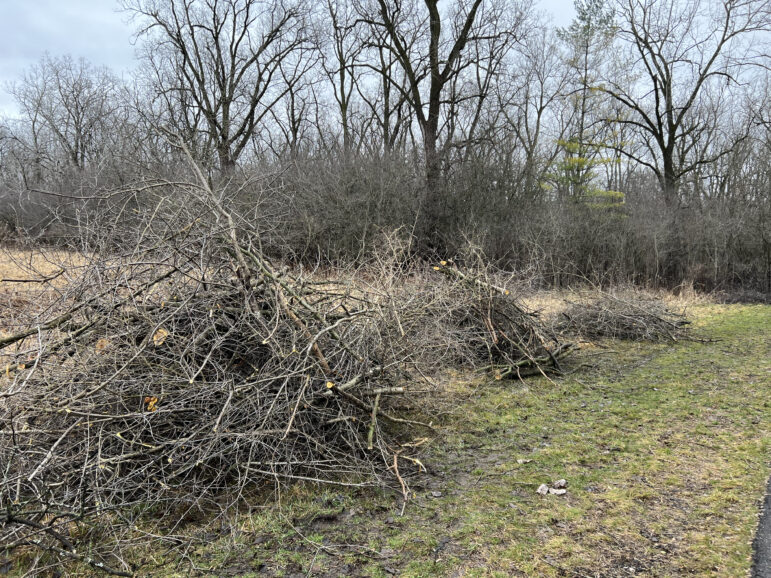It is a brisk March day, and Azaadiika park is finally waking up for spring – birds are flitting through the trees, joggers and dog-walkers are making their way through the winding trails, and a myriad of plant life is starting its journey towards blooming for the season. But there is something there that doesn’t quite belong – a pervasive and ever-growing army of buckthorn trees, an invasive species that has long been a disruptive force in the park’s ecosystem.
“The tree itself takes a few years to grow, but it sends little seeds, and then it sprouts little trees, and those little trees can completely cover a landscape,” says Heather Majano. “So much so, that you could actually take a weed whipper out and just weed whip tiny little buckthorn trees and not have to worry about removing any other plant because that’s all there is.”

Majano, who graduated from MSU with her master’s degree in forestry in 2015, has spent the majority of the past 12 years working as the coordinator for East Lansing’s Environmental Stewardship Program, an initiative focused on reducing the negative impact that invasive species have on East Lansing’s natural environments.
The program, initially founded in 2009 by former Parks and Recreation Commissioner Mike Vasievich, devotes most of its energy towards on-the-ground conservation efforts, inviting community volunteers to meet at designated locations on the second Saturday of every month –both to learn more about the impacts of invasive species, and to help remove or repurpose as many invasive plants as possible.
“I’ve talked to some people who are not as familiar with plant identification, and when they look out in the woods or in a field, they see green, [and think] green is beautiful. And I agree with that,” said Majano. “But when you start getting down into the finer details, you start noticing that the more invasive species there are in a space, the less different varieties of green there are, the fewer different kinds of plants there are. And then the longer an invasive species is in the area, not only are we losing the diversity of native plants, we’re losing the diversity of [all] remaining plants.”

However, invasive species aren’t just a threat to the surrounding plant life – if left unchecked, their spread can also have far-reaching consequences that aren’t always as immediately apparent.
“In general, invasive species are considered a danger to both the economy, human health, and the environment,” said Kelsey Bockelman, the aquatic invasive species educator for MSU Extension. “[They’re] basically crowding out natives, disrupting food webs… they can cause issues both to humans and the native habitats – they can change pH and stuff in water and oxygen levels, they can cause lakes to go very clear… [there are] a lot of ripple effects.”
But despite the passion of the program’s leaders for the work that they do, at the end of the day, the Environmental Stewardship Program is largely dependent on its dedicated volunteers to make its mission a success – and the presence of volunteers can often be determined by factors outside of anyone’s control.
“It’s ebbed and flowed — at its highest, we would have about 1500 volunteers a year,” said Majano. “Then of course, COVID happened, and we went down to zero. [Now] we’re back to about 600 – so, [we’re at] almost a little over half capacity.”
On a day-to-day basis, however, that number can vary even more.
“It definitely depends on the weather,” said Taylor Schellmat, an MSU environmental studies and sustainability major who has worked as the program’s intern since October. “It’s usually something similar to [18-20 people], but when it’s nice weather, it can be like a really big group, like 30 to 40.”
Still, there are those who have remained steadfastly dedicated to the program’s mission, rain or shine.
“My favorite part about the stewardship program is how frequent it runs,” said Keiara Dixon, an MSU global studies in the arts and humanities major who started volunteering for the program in the spring of 2023. “It runs monthly, but it also gives the option for specialized work days, which is something me and my friends take advantage of whenever our schedules align.”
And even despite the setbacks encountered in the face of the pandemic, those heavily involved in the program are overall optimistic about the impact it has had in conserving East Lansing’s natural habitats.
“I think it’s been really impactful,” said Majano. “I know that if there wasn’t this program, that Harrison Meadows Park, specifically parts of White Park, and some of Azaadiika Park would still be completely overrun with invasive plants – whereas now we’re seeing some areas where we removed towards the beginning of my tenure in this position, we’re seeing the diversity of plants coming back.”
But although the program certainly has much to celebrate, its work is far from done – and it is work that can best be achieved with the aid of individuals, who can help not only by volunteering, but also by being mindful and proactive in their day-to-day lives.
“For anyone who’s interested in this, keep going with it,” said Bockelman. “Whether you’re a hiker or a biker or a boater, [work on] knowing how you might come into contact with invasive species, and what you should be doing after each bicycle ride or boat ride to help prevent and do your part as well.”
Schellmat agrees, and recounts instances she’s heard of people who have learned about invasive species through the program, who have since begun to take the initiative to move and dispose of buckthorn they’ve encountered growing on their own property.
“I love to hear when people are taking matters into their own hands, because we can only deal with the parks,” said Schellmat. “So I love knowing that other people are working on it.”